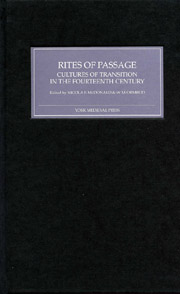Book contents
- Frontmatter
- Contents
- List of Contributors
- Preface
- Introduction: Rites of Passage
- Re-writing a Rite of Passage: The Peculiar Funeral of Edward II
- Coming to Kingship: Boy Kings and the Passage to Power in Fourteenth-Century England
- Boy/Man into Clerk/Priest: The Making of the Late Medieval Clergy
- Manners Maketh Man: Living, Dining and Becoming a Man in the Later Middle Ages
- Rites of Passage in French and English Romances
- Becoming Woman in Chaucer: ‘On ne naît pas femme, on le meurt’
- John Gower's Fear of Flying: Transitional Masculinities in the Confessio Amantis
- ‘Le moment de conclure’: Initiation as Retrospection in Froissart's Dits amoureux
- Index
- YORK MEDIEVAL PRESS: PUBLICATIONS
Introduction: Rites of Passage
Published online by Cambridge University Press: 12 September 2012
- Frontmatter
- Contents
- List of Contributors
- Preface
- Introduction: Rites of Passage
- Re-writing a Rite of Passage: The Peculiar Funeral of Edward II
- Coming to Kingship: Boy Kings and the Passage to Power in Fourteenth-Century England
- Boy/Man into Clerk/Priest: The Making of the Late Medieval Clergy
- Manners Maketh Man: Living, Dining and Becoming a Man in the Later Middle Ages
- Rites of Passage in French and English Romances
- Becoming Woman in Chaucer: ‘On ne naît pas femme, on le meurt’
- John Gower's Fear of Flying: Transitional Masculinities in the Confessio Amantis
- ‘Le moment de conclure’: Initiation as Retrospection in Froissart's Dits amoureux
- Index
- YORK MEDIEVAL PRESS: PUBLICATIONS
Summary
The articles collected in this volume consider a varied and rich array of ritualized events and actions in the lives of late medieval people. They do so by testing the concept of rite de passage, which is now frequently used both in academic discussion and in daily parlance. The term was created in 1907 or 1908 by Arnold Van Gennep (1873–1957), the German-born and naturalized Savoyard folklorist and linguist. Van Gennep saw the life of an individual in any society as a series of passages ‘from one age to another or from one occupation to another’. The rites which attracted his attention were those ‘that accompany transitions from one situation to another and from one cosmic or social world to another’. As a folklorist, Van Gennep was acquainted with the variety of European and extra-European practices related to kinship and the life-cycle. His intuition led him to believe that these might be fitted into categories, and that an underlying structure may be identified in life-cycle rituals:
Since the goal is the same, it follows of necessity that the ways of attaining it should be at least analogous, if not identical in detail.
Van Gennep was eager to bring clarity to the study of these rituals of passage and transition, to make them easy to understand. The anthropology of his day recognized multiple overlapping characteristics of ritual: direct and indirect, positive and negative, contagionist or dynamic, sympathetic or animistic.
- Type
- Chapter
- Information
- Rites of PassageCultures of Transition in the Fourteenth Century, pp. 1 - 12Publisher: Boydell & BrewerPrint publication year: 2004



